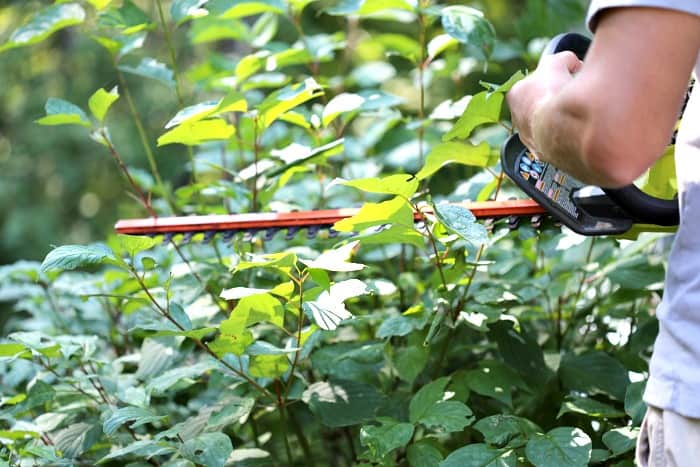Here’s some simple tips on when to prune shrubs so you don’t have to worry about cutting off flower blooms or harming the shrub.
With so many different shrubs, it can be overwhelming to know when to prune them all, especially if you have several different shrub types in your landscape.
Some are deciduous and some are evergreen. Some flower, some don’t. The ones that do flower, flower at different times. If that’s not confusing enough some flower on old wood from the previous years growth and some on new wood from the current seasons growth.
Despite all these different characteristics among shrubs, there are actually some simple rules you can stick to that will ensure you don’t cut off flower blooms or weaken your plant.
Prune Shrubs After Flowering
Lots of people with flowering shrubs are afraid that pruning at the wrong time will cut off the flower buds, which will ultimately lead to a shrub that barely blooms.
This gets confusing because some shrubs get their flower buds on the current seasons growth (new wood) while others get it on past seasons growth (old wood).
You may think you have to research each shrub to determine if they you have a shrub that flowers on new wood or old wood. For the everyday homeowner this can be overwhelming. Luckily, it isn’t necessary to make things so complicated.
All you have to do is wait until your shrub is done blooming, or almost done, and then quickly after you can take out the hedge trimmers or a good bypass hand pruner to give it a trim.
Doesn’t matter if your shrub flowers on old wood or new wood. There’s no risk of cutting off next seasons flower buds because they haven’t developed yet.
When pruning right after the flower bloom period it is important to realize that plants are still actively growing. At this point you only want to take off the top growth and shape the overall plant. You’re cutting into new growth that the shrub put on this past season, not the real woody stuff from years before. When plants are actively growing you don’t want to do a severe pruning where you cut the plant way back. Severe pruning is best done when the plant is dormant in early spring.
Early Spring for Severe Pruning
If you have shrubs that are very misshaped, overgrown, or developing a bad branching habit they may be in need of a severe pruning.
A severe pruning is when you cut the shrub way back. Sometimes this means cutting back to half the size of the shrub, maybe even more.
This kind of pruning is best done in very early spring while the shrub is still dormant. This causes less stress to the plant and also encourages new growth. If you do this severe pruning in late fall there’s a risk the plant can get frost damage. Frost can creep in from the fresh wounds from where the plant was pruned. That’s why early spring, is the best time to do severe pruning of shrubs. This gives the plant plenty of time to recover before next winter.
For shrubs that flower on old wood (which are usually the earliest bloomers) such as forsythias, lilacs, and rhododendrons you have to prepare yourself that if you do a severe pruning in early spring you may get little to no blooms that year.
Cutting off flower buds is a sacrifice you sometimes have to make for the overall health of the plant. This severe type of pruning is not something that has to be done often, certainly not every season. In fact you may not need to do it all. It’s really for plants that are seriously overgrown or need to be trained into a better growing habit.
Selective Pruning
Selective pruning is when you thin out the shrub by removing weak and thin branches, crossing branches, and dead or diseased branches. These are very specific cuts that go deep into the shrub and cut off the entire branch. This type of pruning is a precise cut with a pair of pruners. This type of thinning will help increase the quality and quantity of new growth and flower blooms since less energy will be put into sustaining the weaker parts of the plant. Think of this as survival of the fittest where you’re helping the plant out by getting rid of the weak. This type of pruning should be done in early spring when the plant is still dormant.
Summer Pruning
If you have non blooming evergreen shrubs or non blooming deciduous shrubs, summer can be a great time to shape the plant. In this type of pruning you are shearing the tops of the plant. This neatens up the soft, new growth that the shrub put on this current year. It’s best to use hedge trimmers for this type of pruning but you can use pruners if you had to. This is pretty much one and done meaning you shouldn’t have to prune the shrub for the rest of the season. In the fall you may have a couple of random branches that shoot up but it should be very limited.
Identify Spring Flowering and Summer Flowering Shrubs
If you’re able to determine which shrubs flower on old wood, and which ones flower on new wood then you can arrange your pruning schedule accordingly. Generally speaking, early spring flowering shrubs such as Forsythias, Lilacs, and Rhododendrons, bloom on old wood and therefor you should honor the ‘Prune immediately after flowering’ rule. Shrubs that bloom during the summer months tend to be those that bloom new wood, so therefor you can prune these shrubs in early spring before they put on new growth. At this point in the year they won’t have any flower buds set so there’s no risk of pruning flower buds off. But don’t just assume your summer flowering shrub blooms on new growth. Look it up to make sure!
Categorizing the shrubs in your landscape into two distinct groups, the ones that bloom on new wood and can be pruned in the spring, vs. the ones that bloom on old wood and can’t be pruned in the spring can be more work then some homeowners would like. That’s why this method is considered a little more advanced. Luckily, if this overwhelms you, you can just stick to pruning shrubs after they flower and you’ll know no matter what you’ll be safe.
Avoid Late Fall Pruning
Contrary to a lot of information out there, fall is not a good time to heavily prune shrubs if you are in a region that has cold winters. If you had to, you could prune in very early fall as long as the wounds from the branches have time to heal and seal itself. But don’t wait too late. There are 3 main reasons why late fall is a bad time to prune:
1. Pruning Encourages Growth. This is great in spring, but come fall plants are starting to store energy and get ready to go into a period of dormancy. This is not a time where you want energy being spent on new growth.
2. Increase Risk of Frost Damage. When you prune, an open wound is created on the ends of the pruned branches. These are vulnerable places that can easily be damaged by frost. This will leave you with long sections of dead branches in spring.
3. Risk of Cutting Flower Buds. As discussed earlier, any shrubs that flower on old wood already have next seasons flower buds on them in the fall. If you prune heavily into the shrub at this time you won’t have as many blooms next season.
Light Prune As Needed
At any point during the season shrubs might require a little touch up pruning. This isn’t referring to shearing off all the tops of the whole plant, instead it addresses a couple of random branches that need attention.
Maybe it’s early spring and you see some dead branches or dead tips of branches that formed during the winter.
Maybe its late summer and you notice that after your summer pruning there are some random shoots of new growth.
Whatever the reason, you are safe to do a light pruning at any time.
When to Prune Hydrangeas
Just about half the pruning questions on the internet are related to pruning hydrangeas.
Hydrangeas are one of the best shrubs for long lasting flower blooms and can add a lot of color, especially to shade gardens.
People take their hydrangea blooms seriously. They look forward to them all year and it is one of the most likely flowers people will cut and bring into their home to enjoy.
It can be very disheartening if your hydrangeas fail to bloom, and the likely cause is incorrect pruning.
If you want details on the different kinds of hydrangeas and how they should be pruned, check out: When to Prune Hydrangeas
Check Out These Posts Next
How to Get Rid of Japanese Knotweed
Best Perennials to Grow From Seed
Daylilies: Care, Maintenance, and Uses
Follow Me
Join my free email list!
Plus, follow me on Facebook, Instagram, and Pinterest.



We have a row of roses; some climbers, some tea roses. I have no idea how to prune them. What do you recommend?
Hi William… for the Tea Roses, Don’t be afraid to cut them back pretty aggressively in late winter. Start buy cutting back anything that is old and diseased looking. These canes should be cut all the way off. Same with anything that is as thin as a pencil or thinner. You really want to establish 3-5 solid canes that are solid for the framework of the plant. These 3-5 canes shouldn’t be crossing each other. They should be upright and have space. Cut these 3-5 canes back (about halfway, or even more). Just make sure you cut above above a bud. For climbing roses, prune out anything dead or diseased in late winter. For climbing roses you want to encourage lateral growth. To do this you want to leave the main canes. Pruning them too much will cause the main canes to grow instead of letting the lateral branches grow. It’s these lateral branches that produce the flowers. Giving these lateral branches a pruning will actually encourage them to produce more flowers. I recommend pruning lateral branches back to about 12” of the main cane.
I have a very old hydrangea that my Mom planted 50-65 years ago. Last year my sister moved the plants because it had begun to wilt and die. We moved it to a a space near our door. There are several portions of the original plant. They all bloomed this summer!!! How should I prepare the Bush for the winter? Also when should I prune it to encourage growth? Thank you for your help
Hi Suzanne! Do you know what type of hydrangea it is, or do you at least know if it is one that blooms on the current seasons growth or on the previous seasons growth. If you’re not sure I would prune it immediately after it is done blooming, this way if it does bloom on old wood you won’t risk cutting the flower buds off. As for preparing for the winter, I would just make sure it is getting plenty of water this fall. This will help keep the plant hydrated during the winter. Also I would make sure that there is bark mulch around it. That’s usually all I do. I know some people who wrap their hydrangeas in burlap or some other fabric to protect flower buds from getting a deep freeze (for hydrangeas that bloom on old wood). It does work but personally I can’t stand the look during the winter.
Continuation I live on Long Island in New York. Suzanne